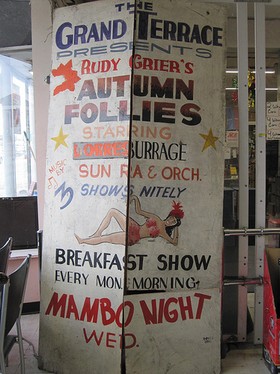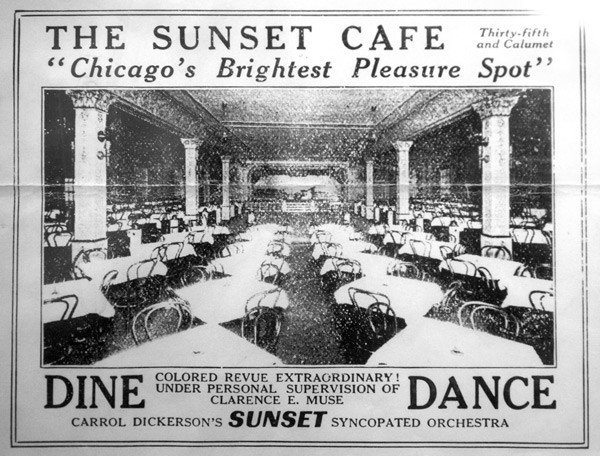The Sunset Cafe
Introduction
Text-to-speech Audio
Images
An original promo poster from the Grand Terrance Cafe.

Early photograph of the Sunset Cafe.

Backstory and Context
Text-to-speech Audio
The building was originally constructed in 1909. The building was once a small automobile garage. The garage was later remold and converted into the Sunset Cafe with a small stage, a dance floor, and multiple tables and seats for customers. It was opened by Edward Fox and Sam Rifas on August 3rd, 1921. A few years later, the building was remolded once more on 1937. The Sunset Cafe was then renamed the Grand Terrance Cafe.
The Sunset Cafe attracted many Jazz legends. Not only did it brought legends to Chicago in the 1920s, it helped launch their careers. Jazz violinist Carroll Dickerson brought many jazz celebrities such as Bix Beiderbecke, Benny Goodman, and Gene Krupa. Jazz legend Louis Armstrong was also an important figure to the venue. He attempted to join the cafe’s band under the leadership of Sammy Stewart. However, he was rejected due to the color of his skin. It was until April 1926 that he secure a spot when Carroll Dickerson retain leadership. Eventually Louis Armstrong became the band leader of the cafe until his return to New York in 1929.
The Sunset Cafe was a Black-and-tan establishment. While many jazz establishments were segregated, venues such as the Sunset allowed entry to both white and Black Americans were they could interact, socialize, communicate, and engaged in other social relations within the perimeter of the cafe. However, due to its high prices, the Sunset Cafe exclude many South Siders. While both Black and white musicians performed on stage, many of the customers` were white.
The Sunset Cafe held significant value to the infamous Al Capone. Joe Glaser’s mother was the original owner of the building until her passing. She leased the building to Edward Fox and Sam Rifas, who were direct employees of Al Capone. After both Louis Armstrong and Joe Glaser left to New York, Edward Fox became the sole manager of both the cafe and the band under the leadership of Earl Hines. Al Capone himself owned 25 percent of the sunset Cafe. Since the Cafe was located within gangland properties, it was that connection that allowed the Sunset Cafe to remain open during the Great Depression, unlike many other jazz clubs.
During Prohibition, The Sunset Cafe was no exception to constant raids. Jazz celebrities such Earl Hines were placed in police wagons and constantly taken to police stations. On November 5, 1927, the Sunset Cafe was shut down after a raid by federal agents. While integrated dancing was common in Black-and-tan establishments, the building was selling bootleg whiskey. Fortunately, the Sunset Cafe was immediately reopen.
The Sunset Cafe closed down in 1940. It became the distract office of Congressman William L, Dawson. In 1970, the building became an Ace Hardware store. The building became an official Chicago Landmark in September 9, 1998. The original murals were kept within the building’s office, until it closed in late 2017. Most recently, the building was converted into an Urban Boutique. The new establishment has kept the original stage art. Due to its status as a Chicago landmark, the building won’t be torn down anytime soon. The owners have also confirmed that the stage art is open for all to see.
Cite This Entry
Eric Serrano. "The Sunset Cafe." Clio: Your Guide to History. March 22, 2019. Accessed March 23, 2025. https://theclio.com/tour/518/11
Sources
Morgan, Andy. The South Side’s Last Remaining Jazz Landmarks. Chicago Magazine. August 29, 2017. . https://www.chicagomag.com/arts-culture/August-2017/The-South-Sides-Last-Remaining-Jazz-Landmarks/.
O'Conner, Robert. The World’s Most Musical Hardware Store. South Side Weekly. February 21, 2017. . https://southsideweekly.com/meyers-ace-hardware-bronzeville-jazz-club-history/.
Sunset Cafe, Al Capone Hangout. Chicago Crime Scenes. January 15, 2017. . https://www.flickr.com/photos/chicagocrimescenes/31489743734.
Levitt, Aimee. Zoom in: Bronzeville. Reader. October 22, 2013. . https://www.chicagoreader.com/chicago/meyers-ace-hardware-bronzeville-jazz-louis-armstrong-sunset-cafe-grand-terrace/Content?oid=11255330.

